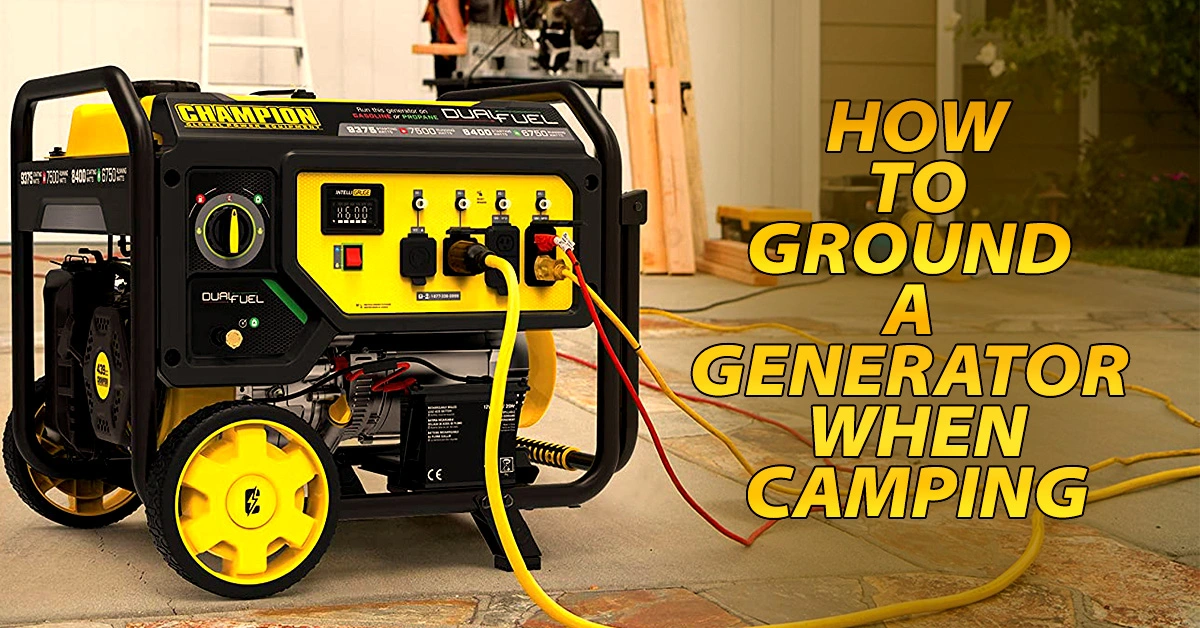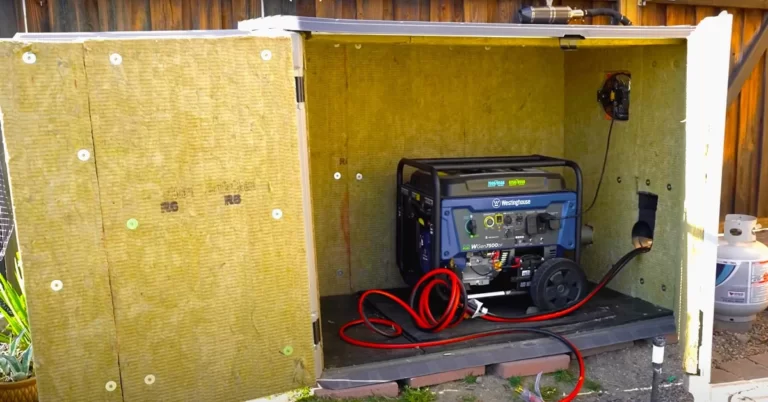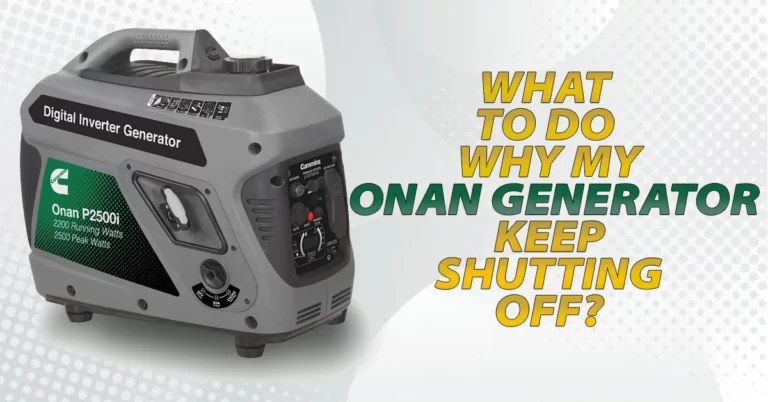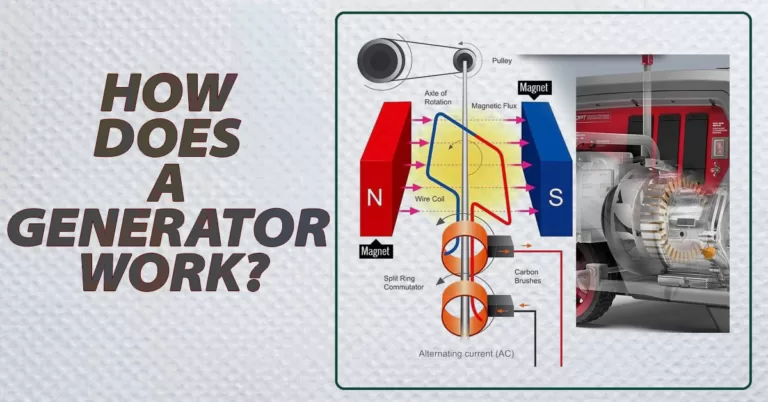How To Ground A Generator When Camping (4 easy steps)
Going camping is an excellent option to escape the noise and bustle of daily life and enjoy some peace and quiet. Camping without power is a little intimidating. There are workarounds for not having power or lighting, but what about using a generator? How to properly ground a generator when camping, so you don’t get shocked by electricity?
We’ll review the tools you need and how to ground your generator correctly.
What Is Generator Grounding?
Generator grounding is the process of connecting a generator’s frame or other authorized equipment-grounding conductors to a grounding conductor, such as a copper wire or rod, that is buried in the soil. This establishes an electrical channel between the generator and the ground, which helps limit the danger of electrical shock and failure. This is done to guarantee safety and safeguard people and equipment from electrical risks. When a current is running through an electrical system, it will naturally follow the route of least resistance to return back to its source. To guarantee that the current goes via the desired channel, it is required to ground the generator properly.
A dangerous scenario may arise when a generator or other item becomes wet. People frequently believe they are secure because they switch off their electronics before leaving. Even with the main power off, water entering your power source can still pose a risk. So that you won’t have to worry about getting shocked, grounding ensures electricity is released from the gadget. By moving the surplus electricity, it regulates it and guards against accidental shocks or electrocution.
A generator that is not properly grounded will emit electricity. This is quite dangerous, particularly if it comes into touch with someone or something metallic. Grounding generators pose a big difficulty since they are not meant to be used outside semi-permanent structures like dwellings and business buildings.
If you want to learn more about grounding, watch the video below, which does it clearly and concisely.
What Are The Supplies Needed To Ground A Generator?
Remember that there are several ways to ground your generator and that the exact procedure you follow will depend on the available tools. Having stated that, here is everything you will require to begin.
Copper Rod
This will ground your portable generator. The minimum length for this rod should be 4 feet, but 8 feet is preferable since a larger rod may enable it to enter the earth deeper for a more secure grounding.
Copper Wire
This is used to connect the generator to the copper grounding rod. Both ends should be de-insulated in order to connect them to the grounding wire and the generator.
Copper Grounding Wire
This links your generator’s grounding pin to the copper grounding rod. The distance between the generator and the buried rod determines how much cable is required to establish the ground connection.
Pair Of Pliers
To provide a strong connection between the two, they used to twist the copper wire close to the grounding rod.
Wire strippers
You must remove the insulation from both ends of the grounding wire on your generator, which the majority do. This is easy using wire strippers since you can attach them to the grounding wire’s copper wire and the generator.
Wrench
The grounding wire has to be attached to the generator after being stripped. To connect the copper grounding wire to the generator, you may need to remove one or more nuts using a tool.
Protective Gloves And Eyewear
To prevent the shock from passing through your hands or eyes, you should also wear gloves and eye protection.
Non-Conductive Tape
You’ll also need to have non-conductive tape so that you can properly insulate the wires.
How To Ground A Generator Step By Step?
Check For Dry Ground
Make sure the ground is totally dry before grounding your generator. Never attempt grounding your generator in rainy weather. Ensure your hands are dry, locate a dry location on the ground, and shield the space from any potential wetness.
Install The Copper Rod
Use a hammer to drive the copper rod at least 8 feet into the ground after you’ve located a dry area to work in. Make sure the rod is firmly in place. If you are camping on rough terrain, it may require extra pressure to get the rod deep enough.
Connect The Copper Wire To The Copper rod
The insulation on both ends of the copper wire should be removed. Make a secure connection by twisting the copper wire’s one end around the copper rod’s top using the pliers.
Connect The Copper Grounding Wire To A Generator
Use the wrench to remove the nut from the grounding pin of your generator. Connect the grounding pin to the copper grounding wire’s stripped end. Tighten the nut to ensure a solid connection. Continue by connecting the grounding wire to the copper rod that has previously been pushed into the ground on the other end.
You may operate your generator immediately without danger of electrical shock or equipment damage by following these instructions for properly grounding your generator. Remember to also check and maintain your generator’s grounding occasionally when camping.
What Else Do You Need?
Electricity will radiate from a generator that is not grounded correctly. This is quite risky, especially if it comes into contact with someone or something metallic. Because grounding generators are not designed to be utilized outside semi-permanent structures like residences and business buildings, they present a significant challenge. These devices will release electricity even when properly grounded; thus, it is crucial to exercise caution. Maintaining a safe distance between other persons, items, and the generator is the best method to avoid risk when utilizing one.
Safety Tip
- Never attempt to install a portable generator yourself; always get an electrician to do it.
- Try to hold off on starting the grounding procedure until you have gathered all of the necessary things.
- Purchase a generator that will provide the necessary electricity without going overboard. It will result in higher fuel costs and less effective generator operation.
- Never run a generator indoors or next to an air intake since they produce a lot of carbon monoxide.
- Although it is feasible to ground a generator, you should always have an electrician do it. It will guarantee that the work is done correctly.
- Regular testing is necessary to ensure that the ground plug is not coming loose. Reinsert the screws if required.
- To prevent short-circuiting or electrocution, generators should be placed away from water sources.
- Never place a generator close to combustibles or fuel sources.
- When utilizing a generator, remember that they are pretty noisy, and some individuals are sensitive to noise.
- Place the generator far from your camping spot to minimize noise disturbance and the risk of carbon monoxide poisoning.
Conclusion:
No matter how old or what you’ll be doing while utilizing it, grounding a generator is essential while camping. Incorrect grounding of your generator might result in an electrical shock that could be deadly or damaging. This article will explain the tools and procedures needed to safely and effectively ground a generator to be ready for operation.
Related FAQs:
-
How To Ground A Portable Generator?
Only the kind of soil and personal preference affect a grounding rod’s depth.
Working with hard soil necessitates going deeper. For soft soil, you may alternatively calculate a depth of around 18 inches. -
What Type Of Cable Do I Need to Ground a Portable Generator
There are several varieties of grounding cables available for portable generators.
However, you can use any grounding connection to ground the portable generator. We advise utilizing a copper-clad ground wire, either No. 4 or 6. -
Do All Generators Need To Be Connected To The Grounding System?
Yes, connecting the generator to the grounding system is required since generators emit a high voltage that may cause fires.
-
What Happens If Your Generator Doesn’t Ground?
Your risk of getting burned or hurt rises if your generator doesn’t ground since the metal casing might become live with the current.
-
Is It Possible To Ground My Generator In My Automobile?
You can connect your generator to your car through the ground, yes. Use a copper cable with a no. 4 or 6 to do this. But make sure that the generator’s grounding point is attached to a metal component of your car.
-
What Is The Minimum Depth Of A Grounding Rod For A Portable Generator?
The grounding rod depth isn’t set. Personal preference and soil type decide.
Hard soil requires deeper planting. In soft soil, expect 18 inches. -
What Is The Best Way To Attach An earth Wire With A Grounding Rod?
You may secure the earth wire with a grounding rod by attaching it with insulated copper staples. For it, you need a copper grounding rod. Use rubber or plastic tape instead of paper for this.
-
What Is The Type Of Cable Used To Connect A Generator To The Ground?
Use a No. 4 or No. 6 copper wire (copper-clad grounding cable) to ground the generator if it has more than 5000 watts. You may ground lesser-wattage generators with a No. 10 copper wire (clad).
-
How Do I Attach Earth Wires To A Generator?
The grounding terminals on your generator are where the earth wire is connected. Using clamps made of a material like copper or aluminum is the ideal method of attaching earth cables. Specific generators have an earth wire linked to them.
-
How Do I Ground The Generator’s Frame?
It would be best if you connected an earth wire to your portable generator’s grounding connection to ground the unit’s frame. Now attach a grounding rod to this wire. And this completes the procedure of grounding your generator.
-
Is It Necessary To Ground My Generator For Tailgating?
Yes, tailgating is necessary for appropriate grounding since generators emit a high voltage that, if improperly grounded, can result in catastrophic harm. In tailgating regions, you can ground your generator using a copper-clad ground cable of either No. 4 or 6.
-
Is It Necessary To Ground My Generator When Using A Transfer Switch?
Using a transfer switch requires grounding your generator, so yes. Transfer switches are employed to connect a portable generator to devices requiring electricity.
Therefore, for security reasons, connecting the grounding system and transferring the switch to the generator is essential. -
What Is The Distinction Between Earthing And Grounding?
Earthing and grounding are the same things.
-
What Is Electrical Grounding?
Connecting a circuit to the earth or another conducting body for safety reasons is called electrical grounding, also known as earthing.







